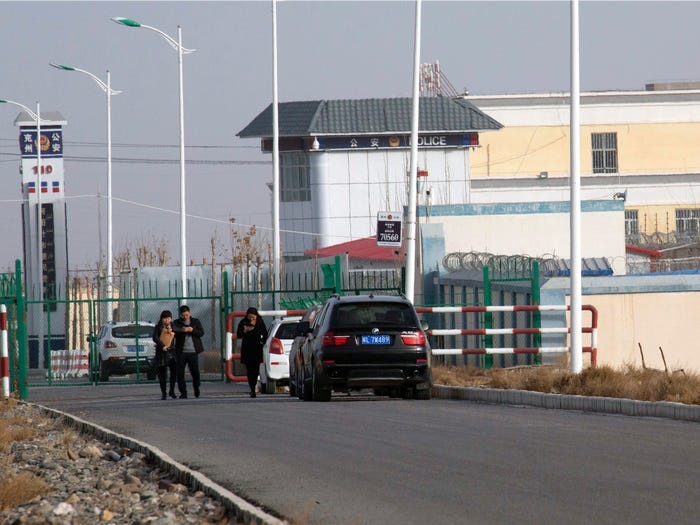- The detention camps where the Chinese government has interned more than 1 million Muslim Uighurs serves a dual purpose.
- It not only oppresses what the Chinese government considers a troublesome minority on its western frontier but also serves as a lab for the development of surveillance technology by Chinese companies.
- China must export these tools as part of its plan to transform its economy into a world leader in technological development.
- "It's not unusual that colonies on the periphery become laboratories of surveillance and control that are then applied elsewhere," Philip Thai, a historian of modern China at Northeastern University, said. "They're doing a lot of testing in an area that is remote and against a people who are not as politically organized or connected."
It is important to understand what's happening in Xinjiang, the far-flung province where the Chinese Communist Party has interned over 1 million Muslim Uighurs and morphed the region into a dystopia of surveillance and terror.
Because to fulfill its economic promises, China must export its methods of repression in Xinjiang to us, the rest of the world.
This is part and parcel of the Chinese government's plan to grow its economy out of debt while evolving it from the world's manufacturing hub to a leader in technological development, a plan called "Made in China 2025."
"To go up the value chain, China has to own the tech that is the tech of the future, so AI, surveillance," Philip Thai, a historian of modern China at Northeastern University, said. "China believes fields like this could help it climb the value chain so it can reap the benefit from exporting these technologies instead of making the lower end and having foreign companies captures most of the gains."
Enter Xinjiang. In part to achieve the dual aims of technological development and a more ideal Chinese society, Xi Jinping's China has turned the region into a testing ground for a dizzying suite of surveillance tools tailor made for use by authoritarian governments.
There are algorithms that predict an individual's activity, from the benign to the dangerous. There's a database that draws from 68 billion records, making the FBI's database of 19 million look like child's play. And of course there's facial-recognition technology. According to The New York Times, Chinese scientists have been gathering blood samples from Uighurs to find a way to map a person's face from their DNA.
To grow profits and ensure technological perfection, this technology must leave China.
The facial recognition technology, for example, must be tested on different kinds of faces. That is why CloudWalk — a facial-recognition company used in Xinjiang — signed a "strategic cooperation" deal with the Zimbabwean government. It needs new kinds of faces so that it can learn to recognize different kinds of people.
The push to develop this kind of technology has become more imperative as the Chinese economy has slowed in recent years. Sectors like manufacturing and heavy industry that used to drive its economy are declining and laden with debt, so the government needs new sources of growth to continue to power the Chinese economic miracle.
And of course time continues to march on to "Made in China 2025" — the year China planned to relaunch itself to the world as a technological juggernaut. If it does it will be, in part, on the back of scientific discovery made through oppression.
 Artux City Vocational Skills Education Training Service Center in Artux in western China's Xinjiang region.
Artux City Vocational Skills Education Training Service Center in Artux in western China's Xinjiang region.
Old, new, and imperative
In some ways, what's happening in Xinjiang is a throwback to the terrors of Chinese Communist Party founder Mao Zedong. Mao believed the CCP could mold people into the perfect citizen, that they could be "reeducated" in labor camps.
Xi Jinping has given this idea a new life, but there are two key ways the new brand of horror is unlike anything China has seen in the 20th and 21st centuries.
For one thing, Xi's violence is racially driven. Mao believed that CCP should avoid "Han chauvinism," the repression of China's racial minorities by its Han Chinese ethnic majority. Xi doesn't see it that way. He's obsessed with the fall of the USSR and, according to Thai, believes that the kind of diversity Mao borrowed from that erstwhile empire helped contribute its downfall. Xi's understanding of the ideal Chinese citizen demands more homogeneity, more secularism.
Put that racism together with the other new feature of Xi's violence — an economic imperative to develop surveillance technology as rapidly as possible — and you have what James Millward, a professor of history at Georgetown University, called "machine-learning-powered discrimination."
"Xi stopped 'hiding his lamp and biding his time' too soon," Millward said quoting a proverb about China's gradual, quiet ascendance to power. "Xinjiang makes China 2025 look like 'Black Mirror.' It has tainted the Chinese technological brand."
Research by Victor Shih, a professor of political economy at the University of California, shows that in the past two years, the Chinese Communist Party all but stopped meeting about reforming China's massive state-owned enterprises, something advanced economies — and especially the Trump administration — have been pushing for years. Instead the government is focused on marshaling the resources of the state to achieve specific political and economic aims. And what's happened in Xinjiang figures into those aims.
"A decade ago the financial system threw resources at state firms so that they could generate growth," Dinny McMahon, a researcher at the Paulson Institute, a think tank dedicated to US-China relations, told Business Insider.
"Today, state firms can still access financial resources, but they're expected to generate growth in ways that serve the national interest (i.e., by moving up the value-added chain and into tech), and by ensuring their internal working culture is politically correct. The role of state companies is now as much about the Party's control over society as much as it is about the structure of the economy."
In these ways, what's happening in Xinjiang is a two-pronged solution for what Xi believes allies China. It is a fix for a lack of social cohesion, and it's a way to secure economic advancement and global leadership with Chinese Communist Party characteristics.
A surveillance iron curtain
Back in 2018 Hank Paulson, the former Treasury Secretary of the United States and founder of the Paulson Institute, gave a speech warning that the US and China — through their various tit for tats — could accidentally find themselves behind an "economic iron curtain." The world once again, he said, is in danger of dividing itself in two.
A year later he reprised his speech, saying that the danger of this economic iron curtain developing is even more acute, especially along the lines of technology.
"Some in the United States now advocate a Cold War-style technology denial regime," he said. "And this is partly because of a growing consensus that China has been using policies and strategies that foster the indigenous development of high technology to set its own standards and, ultimately, pursue self-reliance."
Paulson is right, in part. There are some in Washington who bristle at the idea of Chinese self-reliance, and they should be more focused on US technological development instead.
On the other hand, Paulson's speech is incomplete. In it, he made no mention of surveillance or Xinjiang, of repression as a means of technological advancement. He mentions the Western value of openness, but not the Western value of human rights.
Failing to mention those values over-simplifies technological competition between US and China in this moment. And it risks allowing the planet to divide itself behind a surveillance iron curtain, creating a world where some people have freedom from technological weapons of mass surveillance and some do not.
If we're going to acknowledge what's happening in Xinjiang, we have to acknowledge it's a testing ground for those kinds of weapons and it's China's aim to enrich itself by unleashing them on the world.
Source: businessinsider.com




